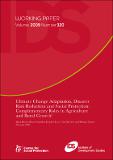| dc.contributor.author | Davies, Mark | |
| dc.contributor.author | Guenther, Bruce | |
| dc.contributor.author | Leavy, Jennifer | |
| dc.contributor.author | Mitchell, Tom | |
| dc.contributor.author | Tanner, Thomas | |
| dc.date.accessioned | 2013-04-03T08:55:25Z | |
| dc.date.available | 2013-04-03T08:55:25Z | |
| dc.date.issued | 2009-02 | |
| dc.identifier.citation | Davies, M. et al (2009) Climate Change Adaptation, Disaster Risk Reduction and Social Protection: Complementary Roles in Agriculture and Rural Growth?, IDS Working Paper 320, Brighton: IDS | en_GB |
| dc.identifier.isbn | 9781858645786 | |
| dc.identifier.issn | 2040-0209 | |
| dc.identifier.uri | https://opendocs.ids.ac.uk/opendocs/handle/20.500.12413/2545 | |
| dc.description.abstract | Reliance on subsistence agriculture means the impact of stresses and shocks (such as droughts or floods) are felt keenly by rural poor people, who depend directly on food system outcomes for their survival, with profound implications for the security of their livelihoods and welfare. However, such stresses and shocks will not necessarily lead to negative impacts, as risks and uncertainties, often associated with seasonality, are embedded in the practice of agriculture and there is considerable experience of coping and risk management strategies among people working in this sector. With climate change, the magnitude and frequency of stresses and shocks is changing and approaches such as social protection, disaster risk reduction (DRR) and climate change adaptation (CCA) will be needed to bolster local resilience and supplement people's experience.
This study examines the opportunities for linking social protection, CCA and DRR in the context of agriculture and rural growth, exploring whether linking these three approaches together will help enhance resilience to shocks and stresses in agriculture-dependent rural communities. The study does this by (i) reviewing conceptual and policy-related similarities and differences between the three disciplines, by (ii) collecting evidence from case studies where climate changeresilient social protection approaches have been trialled and by (iii) developing an adaptive social protection framework that highlight opportunities better coordination.
This paper suggests social protection and DRR measures designed to limit damages from shocks and stresses may not be sufficient in the longer term. For social protection to be resilient to climate change impacts, it will need to consider how reducing dependence on climate sensitive livelihood activities can be part of adaptive strategies. Similarly, CCA and DRR cannot effectively address the root causes of poverty and vulnerability without taking a differentiated view of poverty, something that further integration with social protection can help with. | en_GB |
| dc.language.iso | en | en_GB |
| dc.publisher | IDS | en_GB |
| dc.relation.ispartofseries | IDS Working Paper;320 | |
| dc.rights.uri | http://www.ids.ac.uk/files/dmfile/IDSOpenDocsStandardTermsOfUse.pdf | en_GB |
| dc.subject | Agriculture | en_GB |
| dc.subject | Climate Change | en_GB |
| dc.subject | Social Protection | en_GB |
| dc.title | Climate Change Adaptation, Disaster Risk Reduction and Social Protection: Complementary Roles in Agriculture and Rural Growth? | en_GB |
| dc.type | IDS Working Paper | en_GB |
| dc.identifier.externaluri | http://www.ids.ac.uk/idspublication/climate-change-adaptation-disaster-risk-reduction-and-social-protection-complementary-roles-in-agriculture-and-rural-growth | en_GB |
| dc.identifier.koha | 192042 | |
| dc.identifier.team | Climate Change | en_GB |

